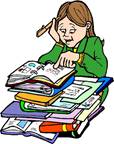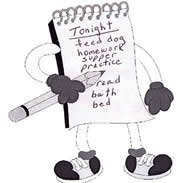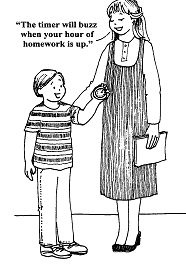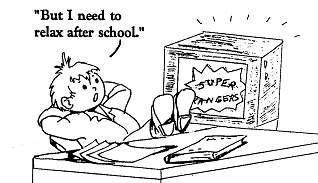WHICH PART OF ORGANIZATION  NEEDS ATTENTION? NEEDS ATTENTION?
Many parents and teachers complain about children's organizational skills, and many kids admit that organizational skills cause them problems in school. Although disorganization is identified as the culprit, parents, teachers, and kids themselves are unclear about what is specifically wrong. By examining the elements of organizational skills, it will be easier to identify and improve the skills that kids need help with. The inset shows the nine main elements of organizational skills. I'll describe each element separately and offer suggestions to help kids improve in areas where they need practice. This will help you to identify your child’s specific problems so he can correct them.
ELEMENTS OF ORGANIZATIONAL SKILLS
Putting like things together. This concept is basic to organization. Whether kids learn to pair socks, put their library books together in a special place on a shelf, organize incomplete homework separate from complete homework, or arrange their favorite singers’ CD’s together, they’re learning an essential first of organization that will help them find what they want when they need it. This skill is so basic that even preschool children can begin learning to put like things together.
 Predicting time. Sensitize kids to how long it takes them to bathe, dress, brush their teeth, or walk to the bus stop and it will help them to be ready on time for school or activities. Noticing how much time it takes to study for a test or complete a math assignment will help them plan. Making them time-conscious will permit them to allocate enough preparation and prevent the daily frenzy that some parents and kids experience when they’re always late. You may want to use a timer or stopwatch at first to measure and chart their time. Once they’re more realistic about their needed preparation, they’ll learn how much time to allow. Predicting time. Sensitize kids to how long it takes them to bathe, dress, brush their teeth, or walk to the bus stop and it will help them to be ready on time for school or activities. Noticing how much time it takes to study for a test or complete a math assignment will help them plan. Making them time-conscious will permit them to allocate enough preparation and prevent the daily frenzy that some parents and kids experience when they’re always late. You may want to use a timer or stopwatch at first to measure and chart their time. Once they’re more realistic about their needed preparation, they’ll learn how much time to allow.
Scheduling. After kids calculate the time it takes for their daily activities and study, they can prepare a weekly schedule to visually understand and communicate their activities for the week. Kids can keep their own schedule and add their personal activities to a family schedule that can be posted on a refrigerator or bulletin board. In this way, parents and kids can better manage carpools, taxiing, and duplication of activities. It may take a fair amount of juggling on the parents’ part to cope with gymnastics, soccer, and music lessons of several children. A realistic schedule helps.
Remembering. Assignment books are great for remembering assignments, as long as kids don’t forget to use them. Kids like to believe they’ll remember their homework or activities without writing them down, but it often is only an excuse for forgetting to do something or be somewhere. Kids have amazing facility at remembering what’s important to them, but falter when their responsibilities are not first priority. Parents who make lists for their own remembering are good role models for kids who must also learn to keep track of responsibilities. Kids can invent their own special system for remembering, but they need to prove it’s effective if they plan to continue to use it.
Prioritizing. As kids’ lives get busier, it’s important to join your kids in prioritizing their most important responsibilities. Discussing priorities helps kids learn to evaluate their activities and determine which ones they absolutely must do and those they can accomplish only if time allows. Prioritizing helps families to balance work and play. Doing homework before watching television may not be a choice kids prefer, but they’ll find it more effective.
Eliminating. In the process of prioritizing, parents and kids together may decide that kids simply have to drop a sport or activity. By discussing what should be eliminated, kids clarify their own values while understanding their parents’ perspectives on activities as well. Sometimes, you may have to insist that kids drop an activity, but it’s better to make this a joint decision and ask for their thoughts on which activity they’d like to drop. There may be times when you’ll disagree. Listen to your kids’ perspectives, but don’t hesitate to speak up if you consider their choices harmful.
 Reviewing. The process of review helps kids to realize that their decisions aren’t permanent and can be revised at a later date. Prioritizing and eliminating will need repetition every few months if schedules become too hectic again. Kids can add activities they’ve dropped or drop some they’ve added as they learn to evaluate their daily lives and interests regularly. Reviewing. The process of review helps kids to realize that their decisions aren’t permanent and can be revised at a later date. Prioritizing and eliminating will need repetition every few months if schedules become too hectic again. Kids can add activities they’ve dropped or drop some they’ve added as they learn to evaluate their daily lives and interests regularly.
Establishing good habits. Study, chores, and organization become much more automatic and less frustrating if kids develop good habits. Doing schoolwork and chores before play is a good habit that prevents procrastination. Rechecking assignments is a good practice for curbing carelessness. It’s also important to avoid bad habits because they, too, can become automatic. Bad habits like skipping breakfast, arguing daily, staying up late, or ignoring homework cause great problems for kids.
Maintaining flexibility. The quotation I enjoy sharing is, “Habits are the best of servants, and the worst of masters.” It’s true that good habits can foster efficiency, but it’s just as true that kids who are mastered by inflexible habits lose opportunities for creativity, spontaneity, and fun. Intentionally teaching kids to make exceptions to their schedules can prepare them to adjust to change and can enhance their lives without destroying their organization and efficiency.
TEACHING GOOD STUDY HABITS
Children with good habits tend to achieve better in school and for the rest of their lives. However, bad habits can interfere with learning, and changing those bad habits can be challenging. Although some children have no difficulty changing their bad habits, others seem to fight habitual behavior of any kind with a consistency that is itself almost a habit.
A TIME AND A PLACE
Good study habits begin with an appropriate time and place for study. A good time for study will have to fit with individual children's other activities as well as their parents' schedules. Study time may need to be quite flexible in many families where parents are not at home when children come home from school; however, some general rules can guide you in setting a proper time and place.
 If children accomplish homework independently and study in a timely manner, there's no need for you to specify a time for study. Children's history of responsibility with schoolwork should determine if parents should set their time for study. On the other hand, if your children haven't been studying enough, If children accomplish homework independently and study in a timely manner, there's no need for you to specify a time for study. Children's history of responsibility with schoolwork should determine if parents should set their time for study. On the other hand, if your children haven't been studying enough,
you should help them structure their time. The amount of time will vary with their grade and school requirements. Elementary school children should study from fifteen minutes to one hour; middle school children, one to two hours; and high school students, one and one-half hours to three hours per evening.
For children who are unaccustomed to spending time studying, I recommend you use a timer and hold them to the specific amount of time initially agreed upon. If children say they have completed all of their homework and have only filled a fraction of their allotted study time, they may use the remainder of the scheduled time for review, organizing notes, or doing extra reading for future book reports or for pleasure. Remind your kids that the timer and prescriptive study times are only a temporary measure to help them manage their study time independently. For children who love to read, permitting them to do pleasure reading during study time may be counter-productive. Writing or math study could complete their study time. Inform them that when their achievement habits improve, you'll be more flexible and allow them to set their own study schedule.
 There should be a break immediately after school for children to have a snack and some physical and social activity. Children often believe they should use that break to watch television. However, television will put them into a passive mode, and they're unlikely to want to leave television to begin studying. It's better to insist that television follow study and homework. It's likely that your children will say, "But I need to relax after school." Assure them that they will get to relax. Exercise is both relaxing and energizing and more appropriate after a day of sitting. Certainly, having time to chat or clown around or play are appropriate for after school, but not television. There should be a break immediately after school for children to have a snack and some physical and social activity. Children often believe they should use that break to watch television. However, television will put them into a passive mode, and they're unlikely to want to leave television to begin studying. It's better to insist that television follow study and homework. It's likely that your children will say, "But I need to relax after school." Assure them that they will get to relax. Exercise is both relaxing and energizing and more appropriate after a day of sitting. Certainly, having time to chat or clown around or play are appropriate for after school, but not television.
In determining the right time for study, there should be something to look forward to after study. If possible, at least part of the children's study time should take place prior to the evening meal, leaving time after study for play or television. If the study time is set late in the evening, study is not likely to be as efficient, and there would not be time after study for play. With only bedtime to follow, they aren't motivated toward efficiency. Homework or study may become an excuse to stay up late if it is scheduled just prior to bedtime. (For some reason unknown to adults, few children seem to enjoy going to sleep.) They often look for ways to stay up as long as adults are awake.
 Having a designated study place is equally important for providing an atmosphere in which children learn efficiently. A desk in a kid's own room with a sign, STUDENT AT WORK, posted on the door is ideal. Many kids have desks, although they may be cluttered with junk. If kids don't have their own rooms, there are other good alternatives. The kitchen, dining room, or basement are reasonable places as long as no one else is in the same room and they're out of listening and viewing range of the TV while they're studying. Having a designated study place is equally important for providing an atmosphere in which children learn efficiently. A desk in a kid's own room with a sign, STUDENT AT WORK, posted on the door is ideal. Many kids have desks, although they may be cluttered with junk. If kids don't have their own rooms, there are other good alternatives. The kitchen, dining room, or basement are reasonable places as long as no one else is in the same room and they're out of listening and viewing range of the TV while they're studying.
USING ALL THEIR SENSES
We know that children vary in their learning styles. Some children learn more efficiently visually; others are more effective listeners and prefer auditory learning, and still others learn best by tactile senses or through hands-on activities. Stories that involve feelings or emotions enhance learning for most children. Using all four styles can encourage your children to utilize their strengths to learn. For visual learners, writing, copying, drawing or collecting pictures will reinforce their memory. For auditory learners, listening to and talking on tapes and oral repetition will assist in improving their memory. Kinesthetic children will learn better by manipulating counters, markers, or flash cards. Teaching children to make up stories, rhymes, or mnemonic devices will assist all of them in involving their feelings to improve their memories. Teach your children to discover what works best for them. Using as many senses as possible for studying will help.
I often tell teachers stories of my fourth-grade teacher, Miss Shoobridge. She was my favorite teacher. I recall that she spoke in a very quiet voice so we had to listen very carefully to hear her. She always shared wonderful pictures from her travels, as well as beautiful nature pictures from the Audubon Society. We also learned to use maps and globes. I loved to touch the continents when it was my turn to go to the map. What I remember most from her class are the stories she shared with us. She was so "human," and not just a teacher. She had a real life outside the classroom, something I never imagined that teachers did. She shared feelings and touched my emotions. She knew how to teach to all learning styles.
|

 NEEDS ATTENTION?
NEEDS ATTENTION? Predicting time. Sensitize kids to how long it takes them to bathe, dress, brush their teeth, or walk to the bus stop and it will help them to be ready on time for school or activities. Noticing how much time it takes to study for a test or complete a math assignment will help them plan. Making them time-conscious will permit them to allocate enough preparation and prevent the daily frenzy that some parents and kids experience when they’re always late. You may want to use a timer or stopwatch at first to measure and chart their time. Once they’re more realistic about their needed preparation, they’ll learn how much time to allow.
Predicting time. Sensitize kids to how long it takes them to bathe, dress, brush their teeth, or walk to the bus stop and it will help them to be ready on time for school or activities. Noticing how much time it takes to study for a test or complete a math assignment will help them plan. Making them time-conscious will permit them to allocate enough preparation and prevent the daily frenzy that some parents and kids experience when they’re always late. You may want to use a timer or stopwatch at first to measure and chart their time. Once they’re more realistic about their needed preparation, they’ll learn how much time to allow. Reviewing. The process of review helps kids to realize that their decisions aren’t permanent and can be revised at a later date. Prioritizing and eliminating will need repetition every few months if schedules become too hectic again. Kids can add activities they’ve dropped or drop some they’ve added as they learn to evaluate their daily lives and interests regularly.
Reviewing. The process of review helps kids to realize that their decisions aren’t permanent and can be revised at a later date. Prioritizing and eliminating will need repetition every few months if schedules become too hectic again. Kids can add activities they’ve dropped or drop some they’ve added as they learn to evaluate their daily lives and interests regularly. If children accomplish homework independently and study in a timely manner, there's no need for you to specify a time for study. Children's history of responsibility with schoolwork should determine if parents should set their time for study. On the other hand, if your children haven't been studying enough,
If children accomplish homework independently and study in a timely manner, there's no need for you to specify a time for study. Children's history of responsibility with schoolwork should determine if parents should set their time for study. On the other hand, if your children haven't been studying enough,  There should be a break immediately after school for children to have a snack and some physical and social activity. Children often believe they should use that break to watch television. However, television will put them into a passive mode, and they're unlikely to want to leave television to begin studying. It's better to insist that television follow study and homework. It's likely that your children will say, "But I need to relax after school." Assure them that they will get to relax. Exercise is both relaxing and energizing and more appropriate after a day of sitting. Certainly, having time to chat or clown around or play are appropriate for after school, but not television.
There should be a break immediately after school for children to have a snack and some physical and social activity. Children often believe they should use that break to watch television. However, television will put them into a passive mode, and they're unlikely to want to leave television to begin studying. It's better to insist that television follow study and homework. It's likely that your children will say, "But I need to relax after school." Assure them that they will get to relax. Exercise is both relaxing and energizing and more appropriate after a day of sitting. Certainly, having time to chat or clown around or play are appropriate for after school, but not television. Having a designated study place is equally important for providing an atmosphere in which children learn efficiently. A desk in a kid's own room with a sign, STUDENT AT WORK, posted on the door is ideal. Many kids have desks, although they may be cluttered with junk. If kids don't have their own rooms, there are other good alternatives. The kitchen, dining room, or basement are reasonable places as long as no one else is in the same room and they're out of listening and viewing range of the TV while they're studying.
Having a designated study place is equally important for providing an atmosphere in which children learn efficiently. A desk in a kid's own room with a sign, STUDENT AT WORK, posted on the door is ideal. Many kids have desks, although they may be cluttered with junk. If kids don't have their own rooms, there are other good alternatives. The kitchen, dining room, or basement are reasonable places as long as no one else is in the same room and they're out of listening and viewing range of the TV while they're studying.